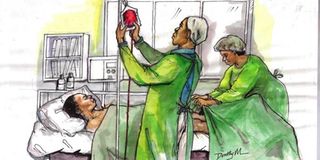Death following wrong blood transfusion - the doctor’s role

What you need to know:
The genesis: A mother died after a blood transfusion. It was later discovered she had been given blood of a group that was not compatible with hers. The family of the deceased accused the doctor of negligence.
The doctor who operated on a mother was sued when the mother died shortly after the operation.
During the operation the mother, whose true blood group was O+, was transfused with blood group B+ instead of being transfused with an O+ blood. The family of the deceased mother accused the doctor of medical negligence when they told court that the doctor failed to:
•Take a full and proper history from the mother and failing to refer to the mother’s previous medical records.
•Pay serious attention to the husband’s statement before the operation that his wife’s blood group was O+ and not B+
•Verify the patient’s blood group in accordance with standard transfusion procedures before transfusing the mother.
•Cross-match the blood found in theatre with the patient’s blood before transfusing the patient with this blood
•Take immediate remedial action after the wrong blood transfusion which resulted in the death of the patient.
The husband of the deceased was emphatic in his testimony to court that both him and the patient informed the doctor that the patient was of blood group O+ and not B+ as had erroneously been indicated on the antenatal card.
The doctor denied all these allegations but instead told court that before the operation was started and given the likely event of severe bleeding, a request was made to the Mulago hospital blood bank to group and cross-match the patient’s blood. Court heard that all the time the operation, which was an emergency, was carried out, there was no one in the Mulago hospital blood bank to group and cross-match the patient’s blood.
Not an easy feat
The doctor also told court that the operation was a very difficult one and lasted for about four hours and that during which, a desperate situation arose when the patient continued to bleed, requiring urgent blood transfusion, which if not given, would have led to the immediate death of the patient on the operating table. In this emergency situation, the anaesthetist found one unit of blood in the theatre which was blood group B+. This was the same blood group as that indicated on the patient’s antenatal card. The doctor then told court that a decision was then taken to dispense of with the procedure of grouping and cross-matching the patient’s blood with the blood found in the theatre in order to save her life as recommended in the National Clinical Guidelines in such situations.
A number of experts were called to guide court during this case. A professor told court that the internal investigations (also known as a maternal death audit) established the patient had started bleeding even before admission and the correct decision was made to operate on the mother. The audit established that the lower part of the uterus was destroyed by the placenta leading to torrential bleeding that failed to respond to conventional treatment, therefore necessitating the removal of the uterus. The audit established that the patient died as a result of excessive bleeding rather than the transfusion with the wrong blood group. The professor’s concluding remarks to court were “I am of the opinion the procedure undertaken in managing the patient’s condition in the circumstances from the time she was admitted to hospital to the time of her unfortunate passing away was proper”
Anything is possible
The postmortem report was no different; the report stated that the patient died because her blood pressure had dropped drastically affecting all the major organs. Further, the patient developed a complication in which the blood started clotting abnormally. What caused the abnormal clotting condition of the blood and the drop of blood pressure could, however, not be established with accuracy. It could have been as a result of the excessive bleeding or the wrong transfusion or both.
An independent expert who testified for the deceased’s family told court that the surgeon had very good intentions in the management of the deceased as the medical assessments were accurate, well intentioned and spot on but was let down by factors beyond the surgeons control. These factors include the laxity or unavailability of staff at the hospital and the insufficient units of blood in the hospital for such an operation.
To be continued



